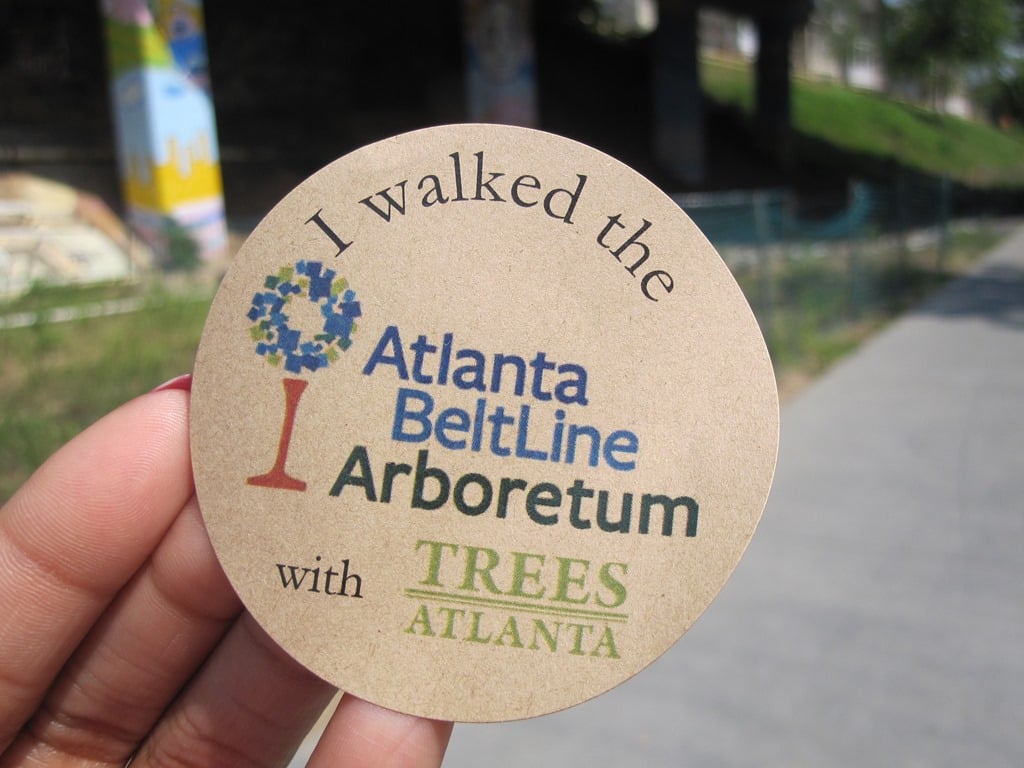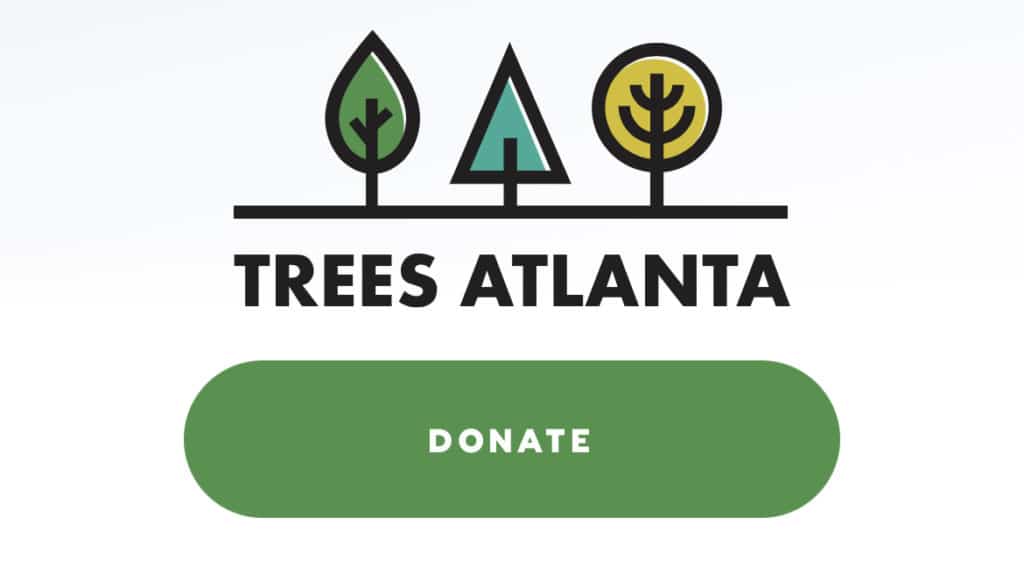August 5th Transform Westside Summit: Highlighting Trees Atlanta
Westside Future Fund’s August 5th Transform Westside Summit highlighted Trees Atlanta’s dedication to preserving Atlanta’s green spaces and supporting the agricultural needs of local communities. Featured Trees Atlanta guests included: Connie Veates, Co-Executive Director and Chief Operating Officer; Greg Levine, Co-Executive Director and Chief Program Officer; Cate Hughes, NeighborWoods Manager; Willette Jackson, Workforce Development & Engagement Supervisor; and Angel Abreu, Youth Tree Team Alumna. WFF President & CEO John Ahmann and co-host Benjamin Earley welcomed another lively audience ahead of the self-moderated panel discussion.
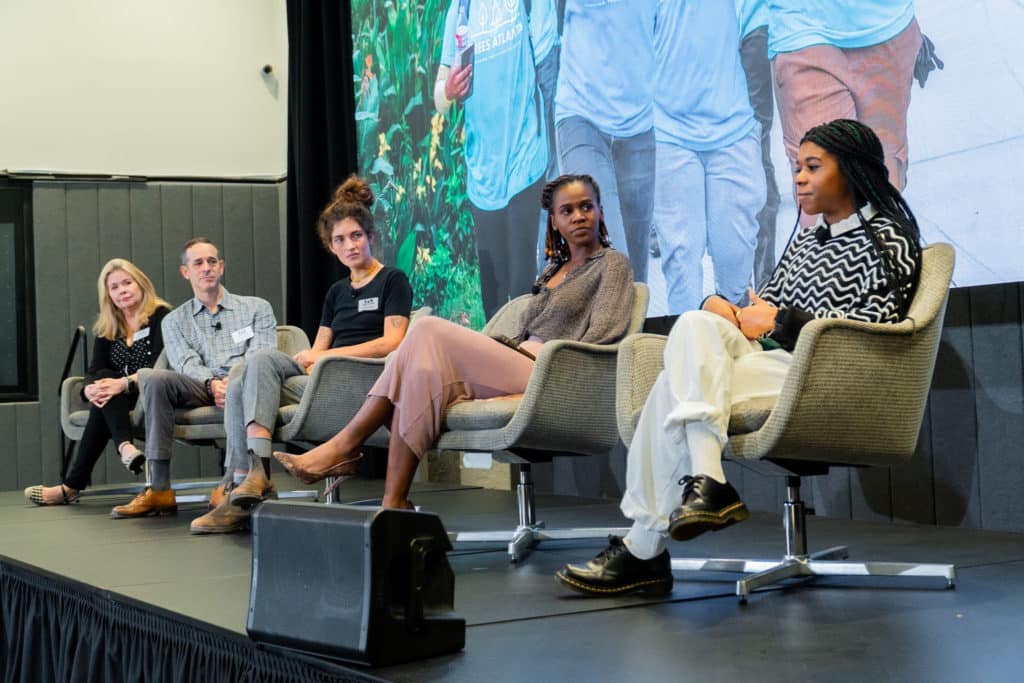
Trees Atlanta personnel (from left): Connie Veates, Co-Executive Director and Chief Operating Officer; Greg Levine, Co-Executive Director and Chief Program Officer; Cate Hughes, NeighborWoods Manager; Willette Jackson, Workforce Development & Engagement Supervisor; and Angel Abreu, Youth Tree Team Alumna
Levine: “We are a nonprofit, we started in 1985. We are a community group that plants, protects, and educates people of the importance of trees. As you know, they’re critical to the health of all Atlantans as they clean the air, filter our water, can slow down storm water…create a place to have peace and relaxation and bring down stress levels which is super important in the stress we’ve been having for the last several years…We started primarily by Central Atlanta Progress, the Parks Department and the Junior League, to focus on the lack of canopy downtown. For those that were here in the early 80’s and 70’s, there was practically zero trees downtown to almost 0% canopy, and that affected the livability and the workability of that neighborhood. As we know businesses were leaving downtown and they were really trying to figure out a way to make people want to be there.”
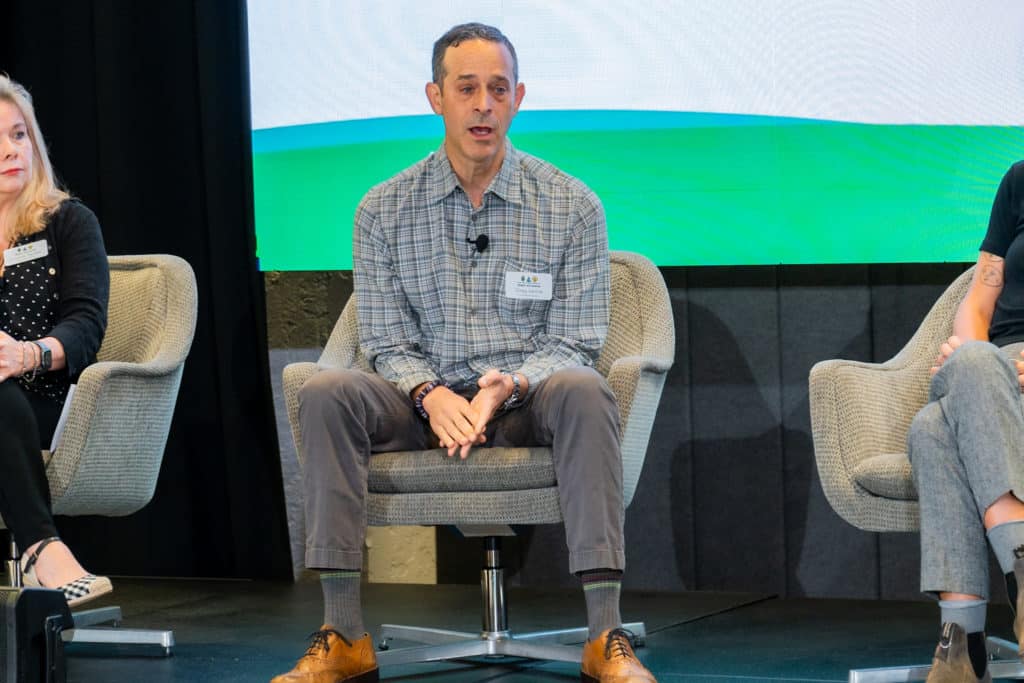
Greg Levine shares how Trees Atlanta’s work has helped improve the quality of life in neighborhoods surrounding downtown Atlanta.
Levine: “Vine City, English Avenue, Summerhill with both flooding and air pollution issues which was causing asthma and things like that. So that was the first program, we planted basic 15-to-18-foot trees. We cut concrete holes, planted the tree in the middle of a sidewalk, and we did that for about five or six years before the community went in to start engaging their own neighborhoods to plant trees. And then we started a program that Cate manages, the NeighborWoods Program. It was our first volunteer program…And last year, we had 37,000 volunteer hours that worked all over the city, putting time back into our neighborhoods in our community.”
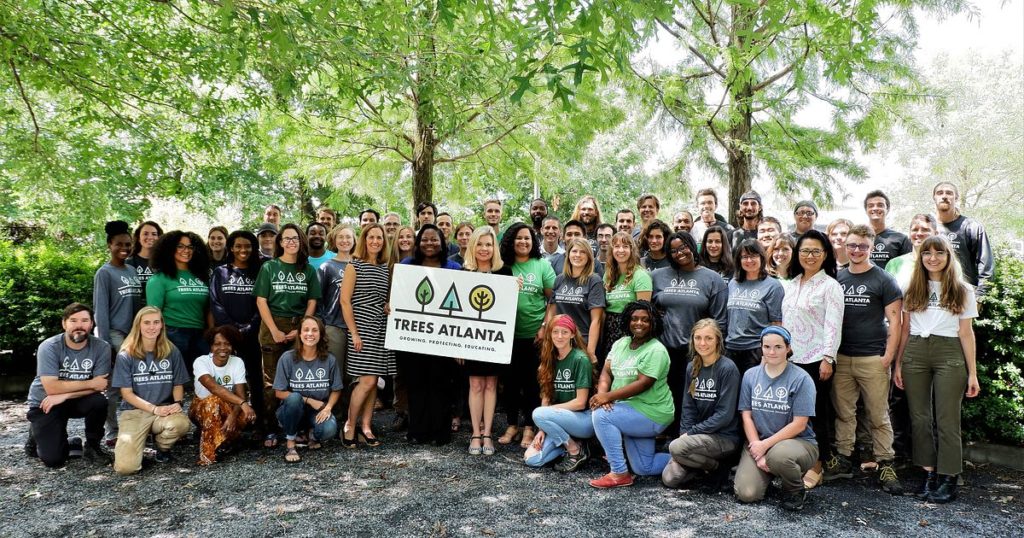
The staff and board of Trees Atlanta.
Levine: “We have forests that are growing but not at their healthiest because we have so many invasive plants and so much edge that sometimes our urban forests need a lot more work than a forest would being in a more natural area. We have invasive plants and erosion…The forest restoration we started in 2000 with a little bit of help from the Arthur M. Blank Foundation. We deal with invasive species, remove them from the forest and regenerate because what was happening and with so many of our forests, is that they became invaded with Kudzu, English Ivy, Chinese Wisteria, and they weren’t doing their best…becoming a monoculture which is not a healthy forest for wildlife.”
Levine: “The last major program I talked about is the BeltLine Arboretum. Arboretum is a public garden focused on woody plants, trees, and we got involved with the Beltline before it was an official program in 2005. And it was to add that green component, we’d like to think it was the icing on the cake, it brought all the layers together to make it delicious. So that they could make it a great project and great program. We have volunteer projects on the Beltline as well. And on a typical Saturday, to get a sense of how many volunteers come out we have about five to six projects every Saturday, and we also have them Wednesday through Friday regularly. That’s a lot of opportunity for the community to make a difference that I want to see in the world.”
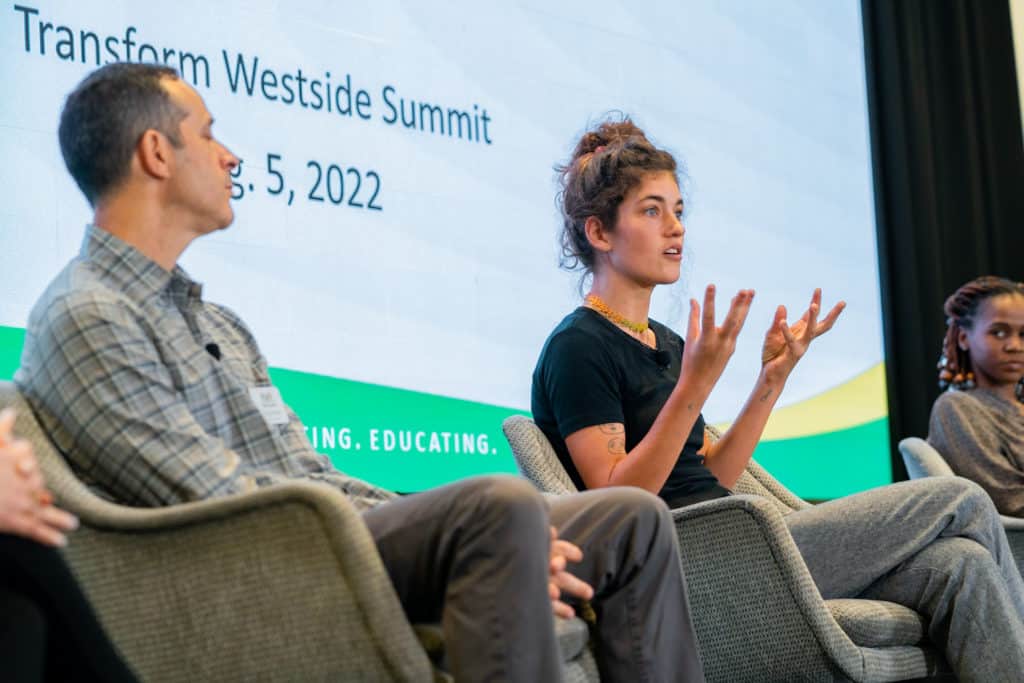
Cate Hughes discusses the NeighborWoods Program.
Huges: “NeighborWoods is our community tree planting program. What me and my staff do is we work with community leaders, residents, and neighbors to plan and plant trees all over the city of Atlanta. These projects come about in a number of different ways. We receive requests from community members, and we also pursue outreach opportunities. We partner with other local organizations to identify places that the community wants trees and I think that that is what grounds our work, is starting from that community driven place. We’re always looking to build new and foster long standing relationships in the communities that we’re working in. Greg mentioned, our big programmatic goal is to increase canopy cover, so we’re always looking to plant canopy trees where they can live. But most importantly, again, is looking to address specifically the needs and desires of whatever particular community we’re working in.”
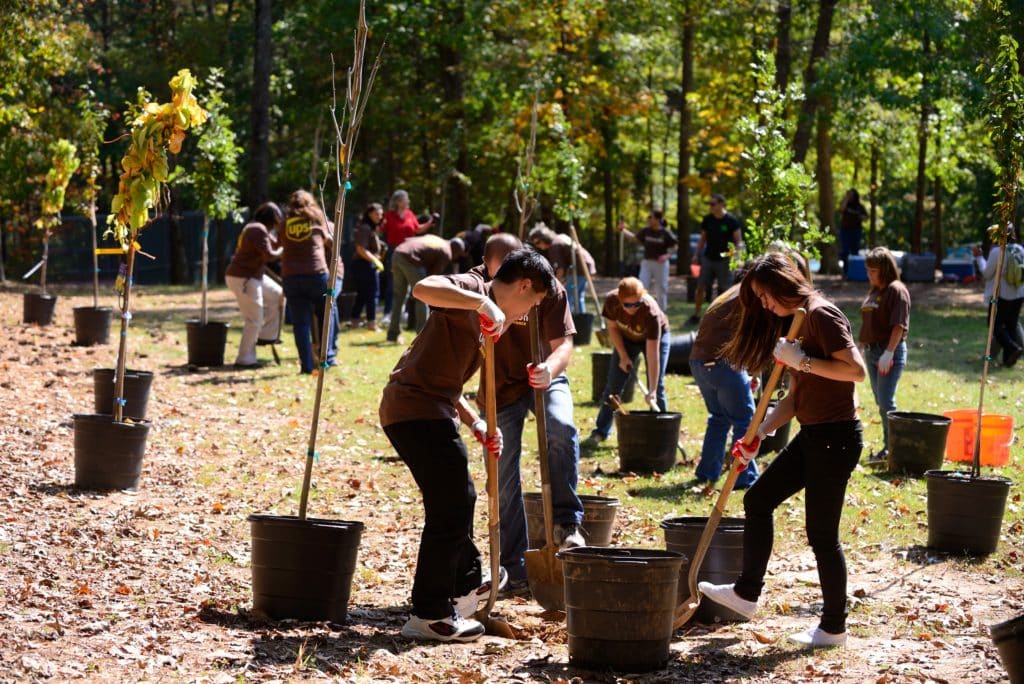
Trees Atlanta volunteers plant new trees to improve the quality of a local greenspace.
Huges: “I was looking at our data yesterday and it says we planted 1700 trees and English Avenue, Vines City, AUC and Ashview Heights. I suspect that number is a little higher. My staff has been working closely with Pastor Winston and Mother Moore in the Beloved Community to help realize the plans for the Brawley-Alexander district by St. Mark’s. So last season, we planted a number of fruit trees there and we’ll come back this season to continue working closely with the pastor to help realize that goal. Part of a broader NeighborWood Initiative in English Avenue is to create that really pollinator friendly, fruit tree neighborhood wide kind of green infrastructure. And that’s been a really exciting project.”
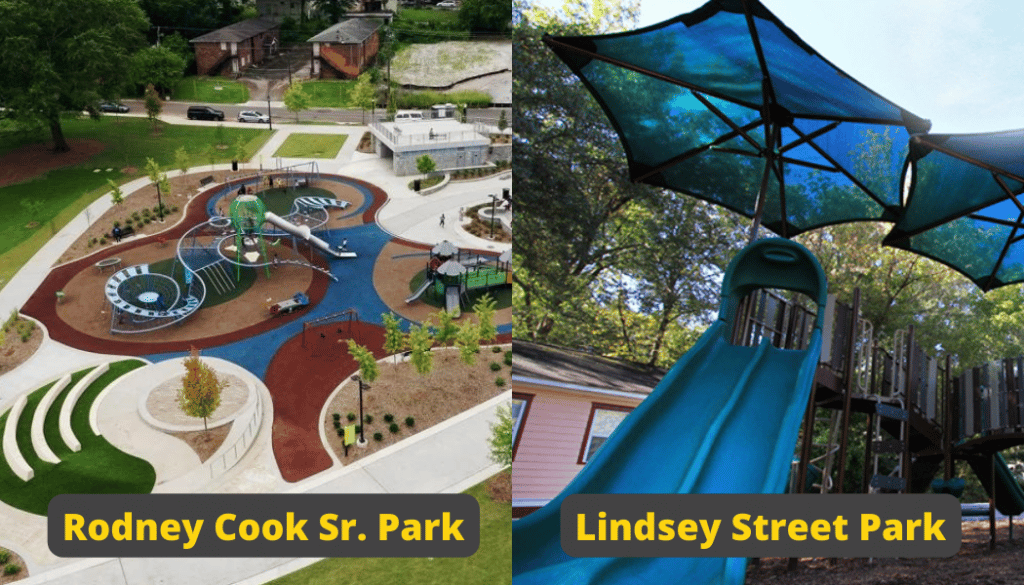
Hughes pointed out Trees Atlanta’s work in two prominent Westside parks.
Huges: “We were involved with planting at Cook Park, which I’m sure you’re familiar with. Lindsey Street Park several years ago, English Avenue’s first park. We partnered with Conservation Fund, Park Pride, WAWA and all the other partners to realize that which has been a really great asset for the community. Greg mentioned the Beltline. We all have volunteer opportunities every Tuesday on the Westside BeltLine to come out with us. Last fiscal year we clocked 2,500 volunteer hours just on the Westside BeltLine alone—such a great, great opportunity to get familiar with that trail. And on that note, volunteerism is a huge part of Trees Atlanta and especially NeighborWood’s work. So, 46% and about 32,000 hours came from NeighborWoods projects in the last year…Community is the people, but it’s also the trees, wildlife, bringing all these things together. And bringing volunteers from all across the city—different walks of life and different backgrounds—all come together to create meaningful, long-lasting change. This impact that is 50 and 100 years from now I think is really, really special and important. At its core, that’s what our work is all about, bringing people together and empowering communities to protect and improve their hyperlocal urban forest.”
Donate volunteer hours or funds to Trees Atlanta today for a greener tomorrow!
Jackson: “I’m speaking about education. We really want to get the youth involved at an early age. I manage our Youth Tree Team, which is our high school workforce development program that mostly focuses on urban forestry, community foraging, agriculture, and horticulture. We recruit from all of Atlanta schools. This year we recruited from four Atlanta counties. The students came from 29 schools, which was amazing…This year, we were able to hire 50 students…so, tremendous growth. This program originally started in 2016…with 12 students. Four out of 48 students graduated so they completed this year and they are actually entering their first semester as college students.”
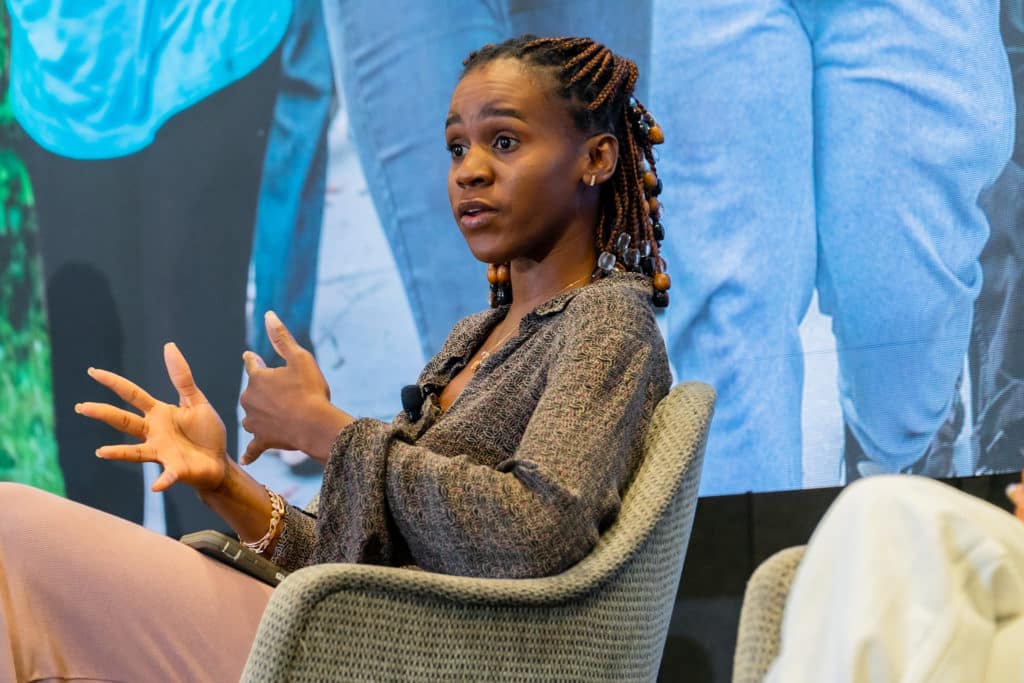
Willette Jackson shares how Trees Atlanta introduces youths to green collar careers and financial literacy.
Jackson: “We are retaining the Youth Tree team after they graduate, which is really important for us to continue to grow through our organization. Four of the Youth Tree team members have worked with us as interns, then we had two of our Youth Tree Team alumni actually be a part of our urban forestry crew this summer, actually maintaining the trees in our green spaces. Youth Tree Team works directly with our crew. All of the spaces they work in actually are spaces we have contracts in. They do weeding, mulching, watering—so a huge part of our maintenance has been done by our Youth Tree Team. They’re really able to see the underlying mission of our work.”
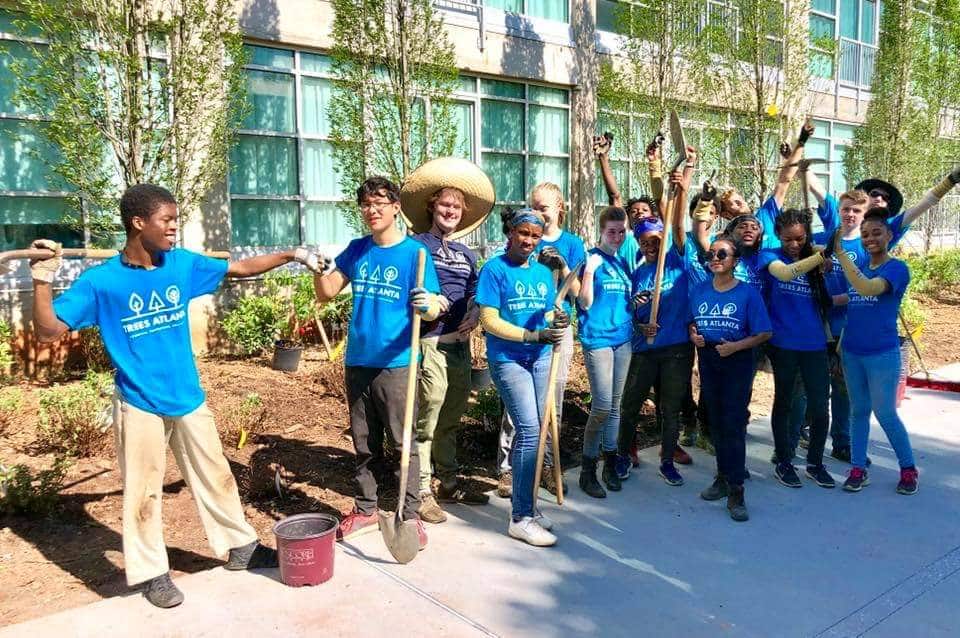
Youth Tree Team members strike a pose.
Jackson: “Some numbers to actually put in perspective that work the Youth Tree Team does: this year they were able to service over 1,345 trees; they used 905 mulch buckets, 3,125 water buckets equaling up to 15,625 gallons of water; and they removed 29.32 [units] of invasive species. That’s really crazy to think about because our crew, they perform this work all summer. That these high school students are coming in at a seven week time frame to do this much work is amazing. The students are able to engulf our mission not only mentally but physically. So that’s really a lot of our mission, to create stewards for the community and now they can pass the knowledge points to their neighborhoods and their family members and friends.”
“We have a financial literacy partner called Community Sustainability Enterprise, and they partner with us to teach our students about financial literacy. They do budget coaching, talk about credit building, how to save for the first car—so a lot of information that we normally receive later in life. That I received when I was 25, the students are able to start to see this information at 14 years old. That’s really amazing. Our financial literacy partner also opens up free checking and savings accounts for the students but also their family members. It’s not only given information to the students, but to their parents, their cousins, creating that family network for a more sustainable and financially stable family. This year, our Youth Tree Team would actually be able to save over $20,000!”
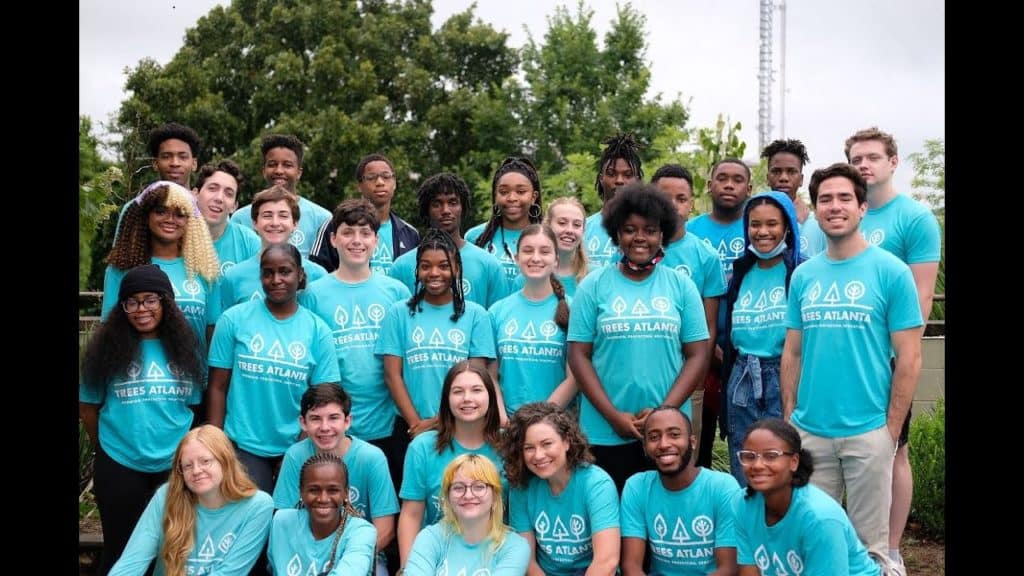
Jackson: “We also share with them our enrichment partners, we take them on field trips to not only talk about the work we do and what’s out there in the green collar industry but really show them in real time, this is a career that can be very fruitful for you and your family. That’s really amazing to see. Our application process starts in November, if you know any high school students who want to be a part of the program. Send them to Trees Atlanta to start the application process…We hire our team by February. We are looking to hopefully hire more than 50 students this upcoming year. We’re looking forward to a successful next season.”
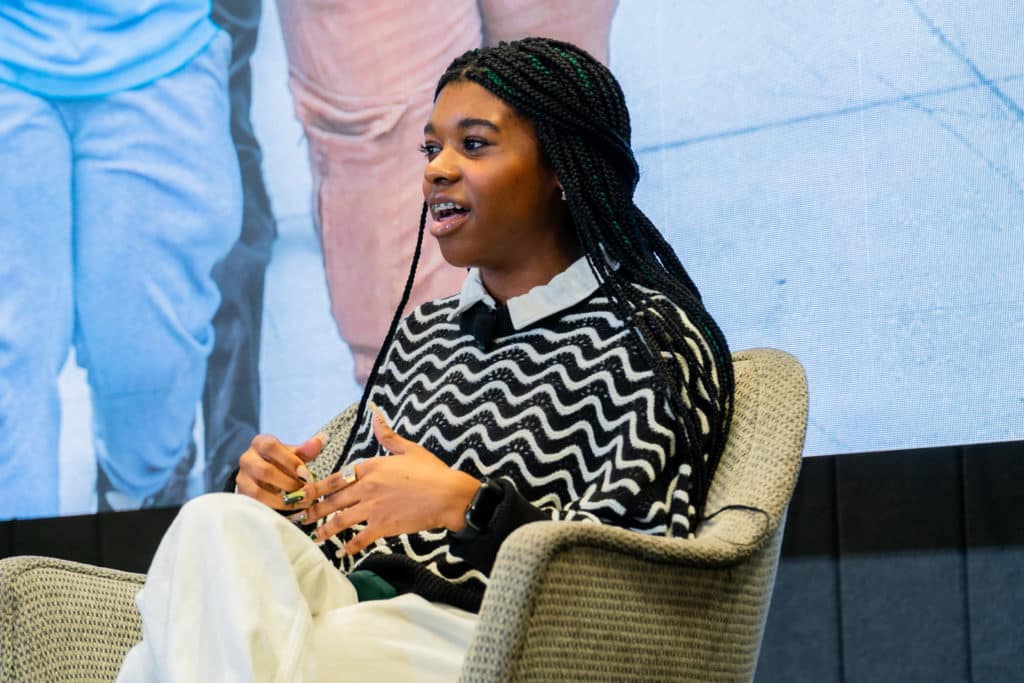
Angel Abreu reflects on spending two exciting summers with Youth Trees Atlanta.
Abreu: “I worked with Trees Atlanta and the Youth Tree Team during summer 2020 and summer 2021, and overall it’s just such a great experience. Being on the team and learning firsthand from everyone above me and everyone around me that was on my level was just one experience I just won’t ever forget. I gained so many skills from financial literacy…Deirdra Cox was one of my financial advisors, and she taught me so much, because here I am. I’m pretty good, financially well-off learning so much and saving so much.”
“We also had many field trips, which is cool. We went to the Atlanta Botanical Gardens, we got to learn about flowers, and all the other field trips helped me open my eyes to other green collar jobs. That was really great because before then, I wasn’t really sure what I wanted to do. Currently I’m a rising junior at Georgia State University. I’m a business major and I was thinking I’m going to go work in an office somewhere, but I think I want to be outdoors and work with trees, the environment and with our community of Atlanta as a whole. We have so much greenery and it’s so beautiful to be able to contribute to helping it grow and seeing my friends enjoy it, being on the Beltline every day.”
“I just want thank Trees Atlanta as a whole for opening my eyes to so many opportunities such as being here today. I thank Travis, Harper, and Dana, Connie, Greg, Cate, Willete. Shout out to you guys like for having me here today and just an overall amazing experience. Like Willette said, if you guys know any teens who want to sign up, want to get out there, want to help the environment, and help other communities, definitely tell them to sign up. And we also have programs for younger kids as well. I have a little brother that I would love to send to the summer camp that we have.”
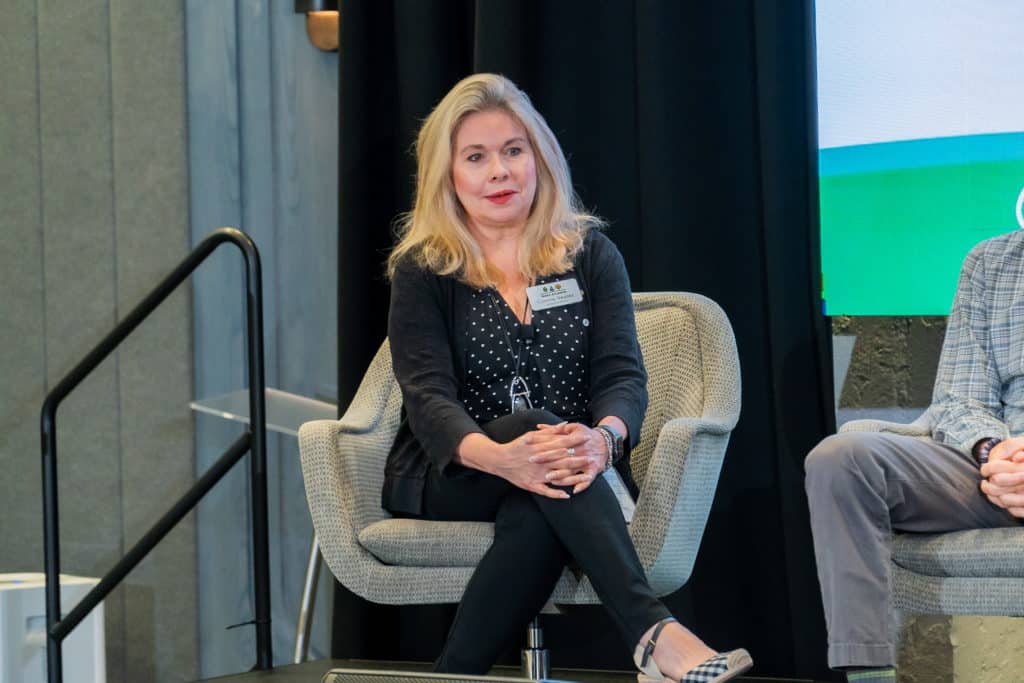
Closing the presentation was Connie Veates, Co-Executive Director and Chief Operating Officer.
Veates: “Trees Atlanta could not do what we do and accomplish what we do if we didn’t have so many great partners. So today I just wanted to talk about two of them, and the first is Westside Future Fund…Part of Greg’s and my job, pre-COVID especially, is to run around the city and meetings, trying to tell our stories and get other people to help us in our mission. Usually we do that apart but sometimes we do it together. It was a hot August day, and Greg and I jump in his Prius to go meet John. And we probably met with him maybe once a year to try to make a partnership, so we didn’t really know him that well. So right before we get off the exit, the Prius decided to stop working. We had about 10 minutes to make it to the Westside Future Fund offices. Greg said, ‘you hop in an Uber and I’ll deal with AAA.’ I said, ‘what are we talking to him about?’”
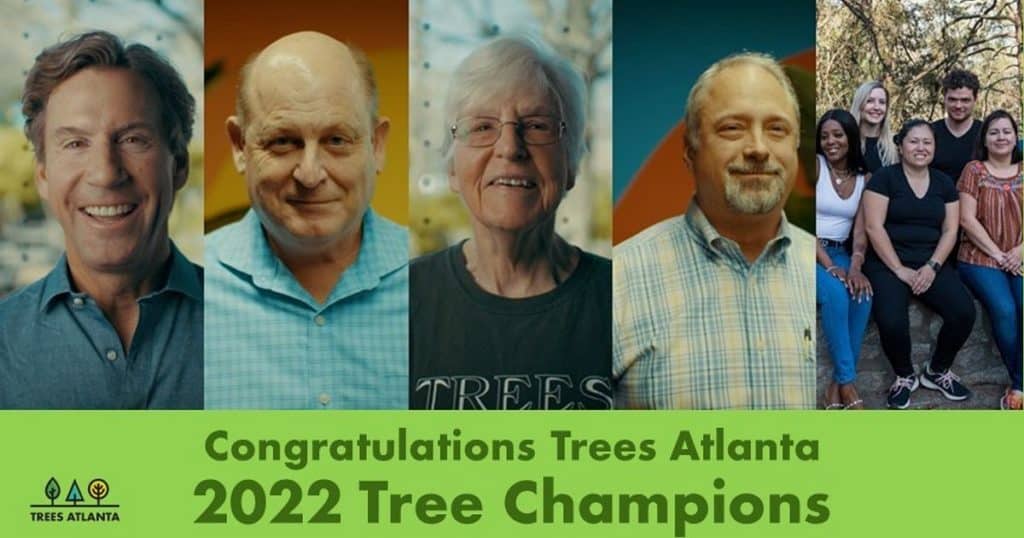
Trees Atlanta recognized WFF CEO John Ahmann as one of its 2022 Tree Champions.
Veates: “[John] said, ‘You know, I love trees, and I think there’s got to be some way we can work together.’ And he really came up with this idea that they were working with some apartment complexes and some multifamily housing. ‘What if we partnered with you guys? We’re gonna have great indoor spaces but, what if we have state of the art, environmentally sound exterior spaces? We can get those communities to have a space where they can go outside and enjoy beautiful nature.’ So that’s what we did. So there were six different units. We worked with John and his board, we helped design those, we added trees to each of the sites and made sure that we increased the canopy. We also added an orchard on English avenue, a small one. When we were through, all the plants were either native or edible. We made sure that there were parking lots, there were playgrounds on each one and the kids could get out. Thanks to John and his vision, we recognized him this year as our partner of the year. We really appreciate that.”
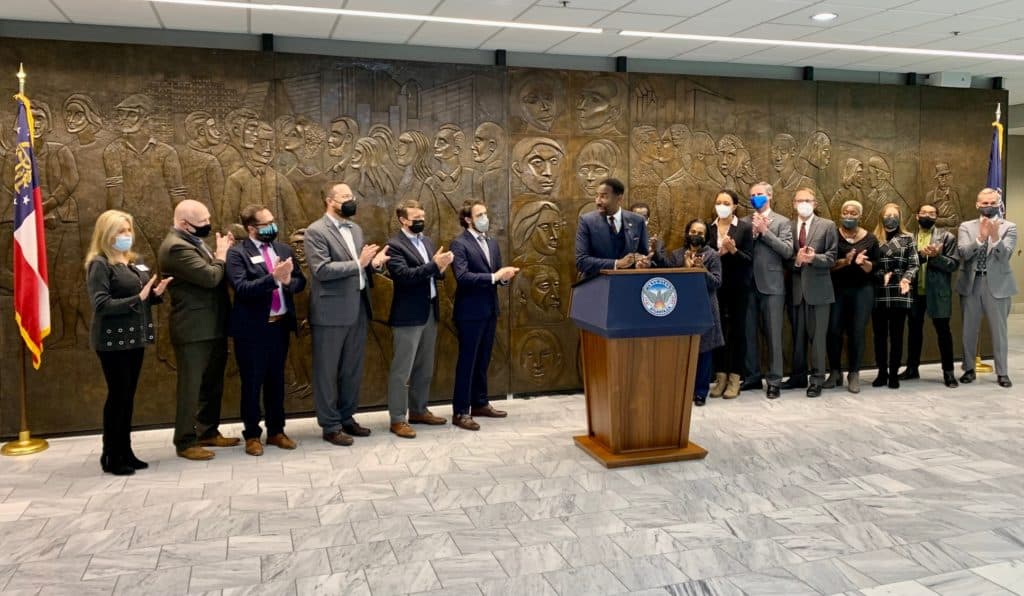
Atlanta Mayor Dickens announcing the Green Cabinet that will support and organize for agricultural needs in Atlanta. Read more.
Veates: “The second partnership I’m talking about is a relatively new one. We have been partnering for years with most of the environmental nonprofits throughout the city. But during the mayoral election, there were about 12 nonprofits that came together, and we met with all the mayoral candidates to really talk about what we do, how we could help the future mayor with green space. We were fortunate that Mayor Dickens was elected. He’s one of the biggest proponents of what we do. He suggested we form a green space advisory council…We meet with him about once every quarter…And we’re actually trying to be thought leaders and proponents to do philanthropic fundraising, whatever he needs to help propel his mission, which is to try to protect and improve parks and green spaces.”
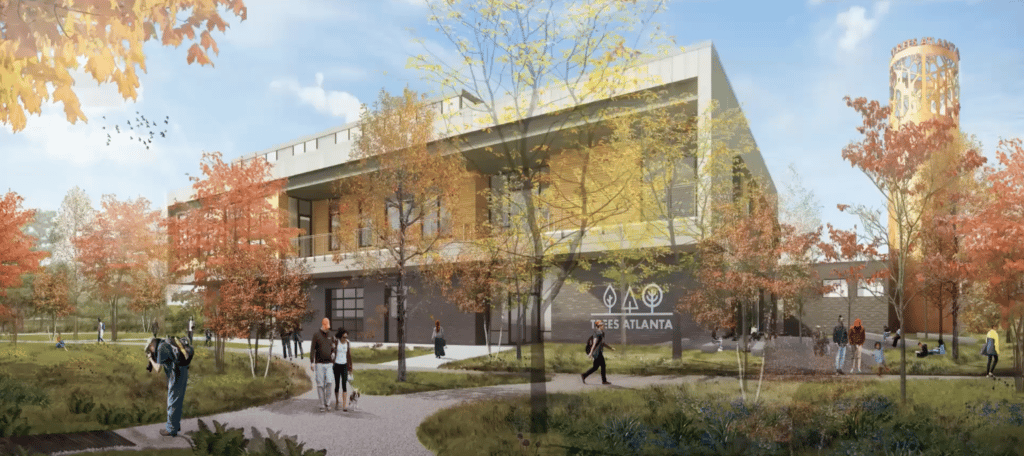
A rendering of Trees Atlanta’s new Headquarters opening in historic Oakland City in 2022.
Veates: “The last thing I wanted to mention is that our current headquarters is in Reynoldstown. We’ve been there 16 years. We started growing so fast, we outgrew it. We had to lease a couple of spaces. Right before COVID, we decided to launch a capital campaign with a new headquarters. Thank you Coxe Curry for helping us do that campaign—we were successful in it. We should be opening our new headquarters in historic Oakland City by the end of the year. We’re very excited about that and we hope you all come to visit us. It will have a community space, they’ll have an education space. It was a brownfield, very industrial site with only two trees on it, and our plans are to add about 200 trees to the location. I think it’d be a lovely place for everyone to come.”
View the full summit including the audience Q&A below!

